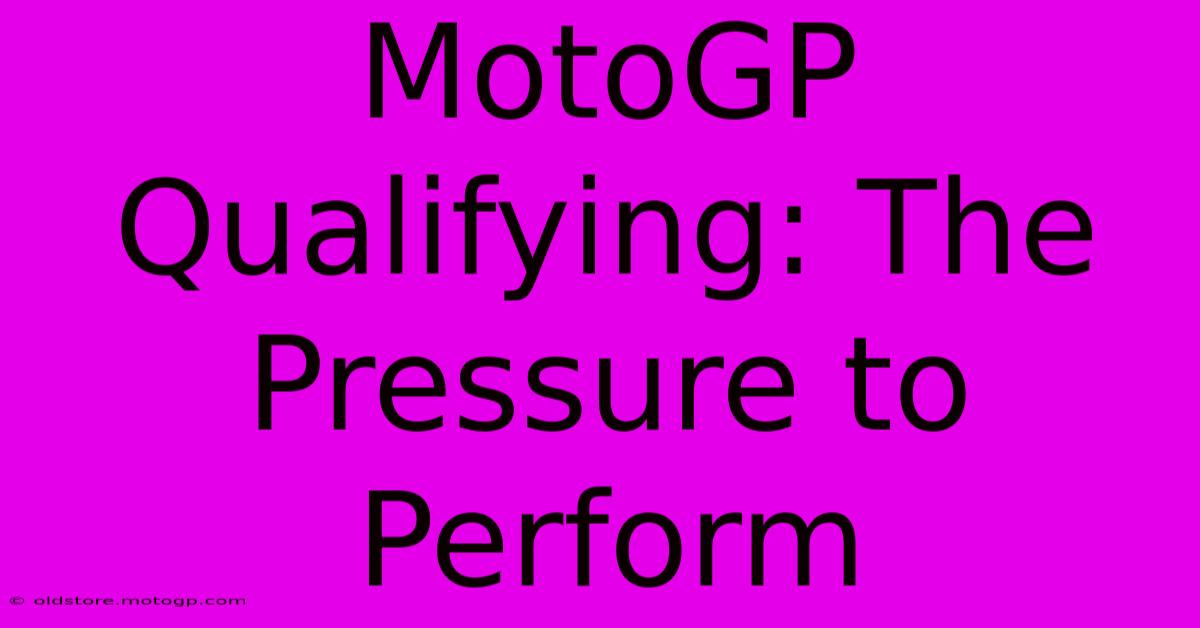MotoGP Qualifying: The Pressure To Perform

Table of Contents
MotoGP Qualifying: The Pressure to Perform
MotoGP qualifying. The mere words conjure images of screaming engines, blurring bikes, and riders pushing themselves – and their machines – to the absolute limit. It's a spectacle of skill, precision, and raw nerve, but beneath the surface of the adrenaline-fueled performance lies immense pressure. This pressure is not just about securing a good grid position; it's about the potential impact on the entire race weekend, the championship standings, and even a rider's career.
The High-Stakes Game of Qualifying
Qualifying in MotoGP isn't a mere warm-up; it's a crucial battle within the larger war of the championship. The starting grid significantly impacts a rider's race strategy and outcome. A front-row start offers a clear track, allowing for aggressive racing and fewer obstacles. Conversely, starting further back means navigating a chaotic first few laps, potentially losing valuable time and positions. This is especially true in MotoGP, where overtaking, while possible, is far from easy.
The Weight of Expectation
The pressure on riders during qualifying is multifaceted. The weight of expectation from their team, sponsors, and fans is immense. Millions of eyes are glued to the screens, and every tenth of a second counts. A poor qualifying performance can lead to intense scrutiny and questioning, impacting confidence and team morale. The pressure isn't just external; it's deeply internal, stemming from each rider's self-belief and desire to succeed.
The Physical and Mental Toll
MotoGP qualifying isn't just mentally demanding; it's physically grueling. Riders push themselves to their physical limits, enduring extreme G-forces and demanding physical exertion across multiple sessions. The combination of intense physical and mental strain can take a significant toll, requiring impeccable physical fitness and mental resilience. A single mistake, a lapse in concentration, or a mechanical failure can erase hours of preparation and potentially jeopardize the entire weekend.
Strategies and Tactics: The Qualifying Game Plan
Teams employ various strategies and tactics to optimize their performance during qualifying. This includes meticulous bike setup, tire selection, and race simulations to predict optimal performance. The choice of tires plays a crucial role, influencing grip and pace. Analyzing track conditions, weather forecasts, and competitors' performance data is also vital. Furthermore, the rider's skill in exploiting the track's nuances and the motorcycle's capabilities makes all the difference.
The Importance of Data Analysis
Modern MotoGP relies heavily on data analysis. Teams use sophisticated telemetry systems to collect and analyze vast amounts of data from each qualifying session. This information helps them fine-tune the bike's setup, understand tire wear, and predict performance in the race. The ability to quickly analyze and interpret this data is crucial for optimizing the rider's performance and maximizing their chances of success.
The Aftermath: Living with the Results
The aftermath of qualifying can be just as intense as the session itself. The thrill of a successful qualifying session is quickly replaced by the pressure of maintaining that momentum throughout the race. Conversely, a disappointing qualifying performance can lead to a period of introspection and recalibration, focusing on race strategy and damage control.
Impact on Race Strategy
Qualifying results directly influence race strategy. A front-row start allows for an aggressive race, focusing on maintaining position and challenging for the lead. A poor qualifying performance necessitates a more cautious approach, focusing on overtaking opportunities and minimizing risks.
In Conclusion:
MotoGP qualifying is a high-pressure environment demanding peak performance from both riders and their teams. The pressure to perform is immense, encompassing physical and mental endurance, strategic planning, data analysis, and the weight of expectation from various stakeholders. It’s a critical battle within the larger championship war, and its outcome often dictates the course of the race and potentially the entire season. The intensity and drama of MotoGP qualifying highlight the incredible skill, dedication, and resilience required to compete at the highest level of motorcycle racing.

Thank you for visiting our website wich cover about MotoGP Qualifying: The Pressure To Perform. We hope the information provided has been useful to you. Feel free to contact us if you have any questions or need further assistance. See you next time and dont miss to bookmark.
Featured Posts
-
Cota Parking Lot T The Smartest Way To Park At Cota
Feb 19, 2025
-
Formula 1 Shuttle Arrive In Record Time
Feb 19, 2025
-
The Greatest Moto Gp Rider The Heart Of A Champion
Feb 19, 2025
-
Experience The Roar Of The Engines Motorcycle Race Austin Tx
Feb 19, 2025
-
Moto Gp Sprintrennen The New Standard In Motorcycle Racing
Feb 19, 2025
